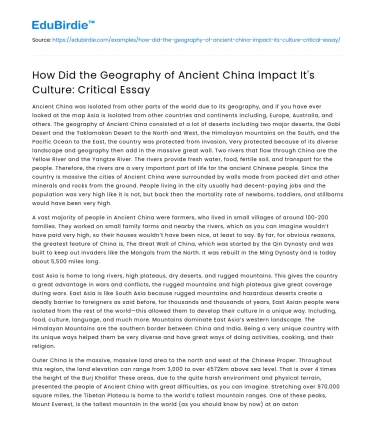Ancient China was isolated from other parts of the world due to its geography, and if you have ever looked at the map Asia is isolated from other countries and continents including, Europe, Australia, and others. The geography of Ancient China consisted of a lot of deserts including two major deserts, the Gobi Desert and the Taklamakan Desert to the North and West, the Himalayan mountains on the South, and the Pacific Ocean to the East, the country was protected from invasion, Very protected because of its diverse landscape and geography then add in the massive great wall. Two rivers that flow through China are the Yellow River and the Yangtze River. The rivers provide fresh water, food, fertile soil, and transport for the people. Therefore, the rivers are a very important part of life for the ancient Chinese people. Since the country is massive the cities of Ancient China were surrounded by walls made from packed dirt and other minerals and rocks from the ground. People living in the city usually had decent-paying jobs and the population was very high like it is not, but back then the mortality rate of newborns, toddlers, and stillborns would have been very high.
A vast majority of people in Ancient China were farmers, who lived in small villages of around 100-200 families. They worked on small family farms and nearby the rivers, which as you can imagine wouldn’t have paid very high, so their houses wouldn’t have been nice, at least to say. By far, for obvious reasons, the greatest feature of China is, The Great Wall of China, which was started by the Qin Dynasty and was built to keep out invaders like the Mongols from the North. It was rebuilt in the Ming Dynasty and is today about 5,500 miles long.
East Asia is home to long rivers, high plateaus, dry deserts, and rugged mountains. This gives the country a great advantage in wars and conflicts, the rugged mountains and high plateaus give great coverage during wars. East Asia is like South Asia because rugged mountains and hazardous deserts create a deadly barrier to foreigners as said before, for thousands and thousands of years, East Asian people were isolated from the rest of the world—this allowed them to develop their culture in a unique way. Including, food, culture, language, and much more. Mountains dominate East Asia’s western landscape. The Himalayan Mountains are the southern border between China and India. Being a very unique country with its unique ways helped them be very diverse and have great ways of doing activities, cooking, and their religion.
Outer China is the massive, massive land area to the north and west of the Chinese Proper. Throughout this region, the land elevation can range from 3,000 to over 4572km above sea level. That is over 4 times the height of the Burj Khalifa! These areas, due to the quite harsh environment and physical terrain, presented the people of Ancient China with great difficulties, as you can imagine. Stretching over 970,000 square miles, the Tibetan Plateau is home to the world’s tallest mountain ranges. One of these peaks, Mount Everest, is the tallest mountain in the world (as you should know by now) at an astonishing 8.8477344km. Despite its freezing temperatures and enormous heights, it was once years ago home to a thriving kingdom that thrived and lived around 800 CE and developed into an independent country.
Today, China controls this area known as the country of Tibet. Much of the Chinese settlements and history owes a great deal of gratitude to the plateau because the melting glaciers provide fresh water to two of China's greatest rivers, the Huang He and the Chang Jiang. Over 2 billion people today depend on these rivers for survival and to thrive in their human life, In ancient times, the plateau was too cold for farmers to grow crops on consistently. Instead, the early settlers relied on roaming animals such as yaks and goats for their meat, fur, and milk to stay alive in these parts.
Two of the great deserts mark and make the landscape of Outer China's northwestern region so diverse. These two deserts are almost complete opposites of each other. The Taklamakan is much smaller compared to the Gobi; however, the Taklamakan is known as one of the world's most dangerous with sand dunes that are over 91.44 KM tall and temperatures rising well over 100 degrees, stepping one bare foot on that sand would cause 3rd-degree burns or worse. The Gobi Desert is a cold desert. Its higher elevation contributes to the sharp temperature difference, but it does not mean that its climate is easier to handle than its friend. The temperature can swing 60 degrees from one direction to the other in less than 24 hours! Early settlers of these deserts survived by finding oases deep down within the deserts. These provided great places to grow crops, raise animals, and create mud-brick homes. So could you believe that people actually lived on these monstrosities?






 Stuck on your essay?
Stuck on your essay?

